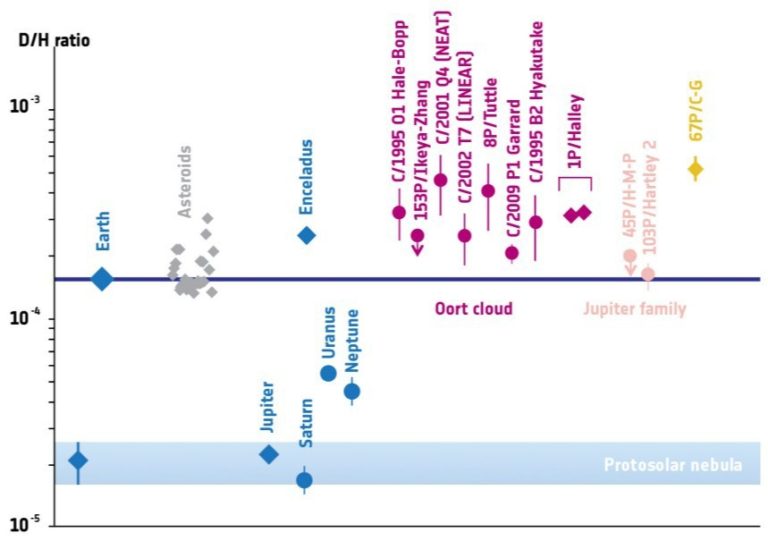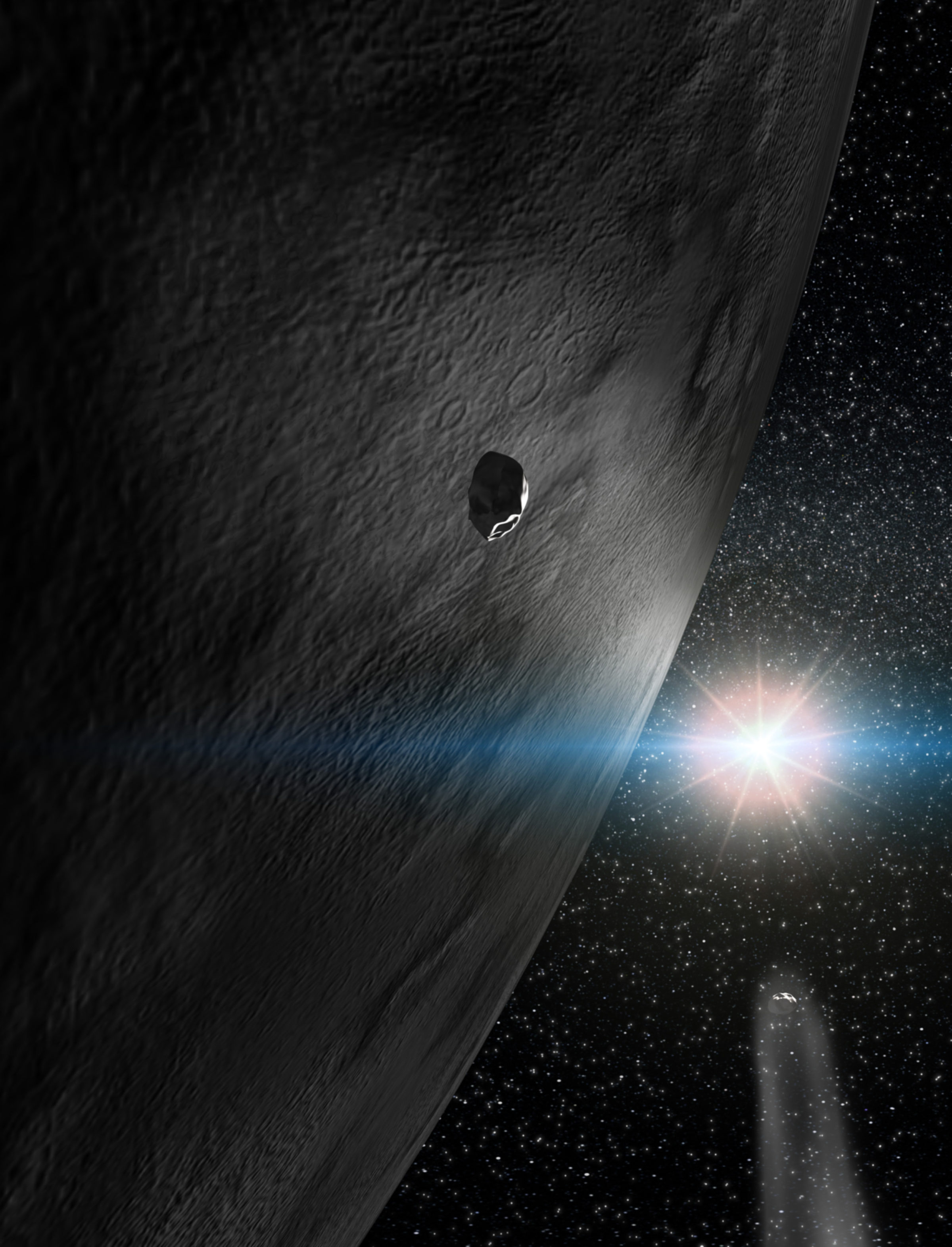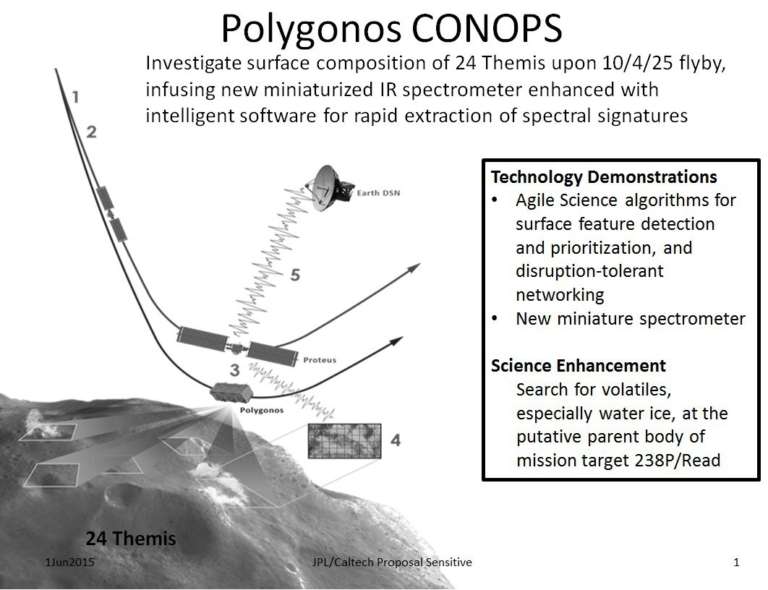Van Kane • Sep 17, 2015
Searching for the Origins of Earth’s Water
Sometimes planetary exploration is drama and new vistas: Seeing the most distant planet for the first time, a harrowing landing on Mars, the fight for survival of a probe lost on a comet. Much of planetary science, though, builds up from many quiet measurements that provide crucial insights that can change our understanding of the solar system and our world’s place in it. Today’s post is a about a group of proposed missions that fall into that latter category.
(Oh, and before anyone reminds me that Pluto is no longer a “planet”, there are scientific classifications and personal ones. Pluto emotionally will always be the planet on the distant edge of the solar system for me.)
One of the knottier problems in planetary science is understanding the origins of Earth’s water. In the infant solar system, a temperature gradient extended from our star to the outer solar system. Close to the sun, rocky materials with high melting points could have condensed. Somewhere, possibly in the region of the mid-asteroid belt, it became cool enough for water ice to condense. In the far outer solar system, even materials that are gases on our world would have frozen out to create, among other features, the plains of frozen nitrogen found on Pluto by the New Horizon’s spacecraft.
In this model, our early planet fell on the wrong side of the dividing line – referred as the snow line – for water to have condensed and become part of our world. In one sense Earth remained a dry world with much less than 1% of its mass as water. By comparison, the asteroid Ceres, on the other side of the snow line, may have as much as 50% of its mass in water, liquid or frozen.
Yet on Earth’s surface, water is abundant in our atmosphere, soils, and oceans with perhaps several times as much water again contained in the rocks of our planet’s crust and mantel. How was this critical substance delivered to our world?
Scientists have long suspected that Earth’s water was delivered from somewhere in the outer solar system by icy bodies colliding with the proto-Earth. But from which region of the outer solar system? And what dynamic processes perturbed those bodies into collision courses with our rocky inner world?
Karen Meech from the University of Hawaii puts the importance of this science this way: “The compelling question to learning how Earth got its water isn’t just about the Earth. If our solar system was somehow special and required a special architecture to deliver water to our world, what does that say about the thousands of worlds around other stars? Would planets in the habitable zones around these stars have water to support life? This question impacts the big question of ‘is there anybody else out there?’”
We won’t be able to answer this question until we have analyzed the chemistry at bodies that represent several potential sources of water and volatiles for our own solar system. At least three teams of scientists are proposing missions to explore these bodies.
Water is abundant in our solar system, especially in the worlds that formed beyond the snow line. Ceres is one example of an asteroid on the far side of the line with substantial water. Many of the moons of Jupiter, Saturn, Uranus, and Neptune have vast quantities of water. Comets and the worlds beyond Neptune, of which Pluto is the largest example, have substantial water. Earth’s water could have come from any of these regions, or perhaps a mixture. There’s also the possibility that the rocky grains that condensed to form Earth absorbed some of the water vapor surrounding them, or that water was made on Earth’s surface when hydrogen in our planet-forming disk combined with molten rocks on Earth’s surface.
If this sounds like a messy problem, it is. The solution to finding the sources of the Earth’s water lies in chemistry. Water itself varies in its isotopic composition between normal water with hydrogen atoms containing no neutrons and the much rarer one-neutron hydrogen, deuterium. The ratio of these two water types, abbreviated to D/H, varies among the bodies of the solar system (you can read about D/H ratios in two Wikipedia articles here and here). The smallest ratios are found at Jupiter and Saturn, followed by Uranus and Neptune, and then primitive meteorites. Earth, Mars, a few comets, and interestingly Saturn’s moon Titan have similar D/H ratios. Saturn’s moon Enceladus, however, has a higher ratio. Some comets have D/H ratios similar to Earth, while others have higher ratios.

Finding an icy body with D/H ratio similar to Earth’s suggests that it could have formed in the same region as the bodies that supplied water to Earth because the amount of deuterium that gets captured in molecules is a sensitive function of temperature. That, though, is just the beginning of the detective work. Early in the solar system, the orbits of the giant planets migrated in and then out again. In the process, they scattered many of the smaller bodies around the solar system (and ejected many from the solar system altogether). The goal is not just to find bodies with similar chemistry to Earth’s water, but also to look for clues as to where these bodies might have originally formed before they were scattered.
Chemistry again should provide the critical clues. Isotope ratios such as those of 17,18O/16O[xygen] and 15N/14N[itrogen], along with the amounts of noble gases such a krypton and argon, can reveal clues such as the temperature at which a body formed or the distance from the sun where it formed. Comparing different groups of isotopes and elements will allow scientists to explore multiple lines of evidence.
To explore the origins of Earth’s water, scientists need to deliver a capable chemistry lab to different worlds that are the remaining representatives of early reservoirs of water and volatiles. Three teams—two American and one European—are proposing missions to do this to their respective low cost planetary programs (the Discovery program for NASA and the Medium class program for ESA).
The core instrument for all three proposed missions would be a mass spectrometer. These instruments sniff in gases or vaporized grains of ice and then “weigh” the distribution of their molecules and isotopes. The two NASA missions propose to use a cutting edge advanced mass spectrometer, MASPEX, that is both highly sensitive to trace amounts of material and can measure large complex molecules. MASPEX has been selected for NASA’s Europa mission and is proposed to be used by at least three Discovery missions (the two discussed in this post plus one that would study the gasses emitted by Saturn’s moon Enceladus). The specific mass spectrometer for the European mission isn’t specified. (For a brief and easy to read overview of mass spectrometers, check out this document from JOEL USA, which manufactures commercial instruments. You can read a technical overview of the MASPEX instrument here.)

The Primitive Materials Explorer (PriME) Discovery mission would return to comet Hartley 2, which was briefly studied during a flyby with the Deep Impact/EPOXI spacecraft, for an extended study. Measurements by a European space telescope, Herschel, measured the D/H ratio for this comet and found that it is similar to Earth’s oceans.

The other two proposed missions would travel to an entirely different potential source of Earth’s water. Several asteroids, including Ceres where Dawn is now exploring, have been observed by telescopes to emit dust and water vapor. Five asteroids emit so much dust, forming a comet-like tail, that they are called main belt comets (MBCs). Because the dust comes off the MBCs every time they make their closest approach to the sun, it is clear that heat is causing water to escape, pushing dust from the surface.
Telescope measurements of one of the larger (~200 km diameter) and more distant main belt asteroids, 24 Themis, suggest that there may be water ice with some organic compounds on its surface (see the press release here). Conveniently, past collisions have chipped off pieces of the parent asteroid, potentially allowing scientists to examine material that potentially previously lay beneath the surface. One of those chips, tiny (estimated 0.6 km diameter) asteroid 238P/Read, has been observed to have strong, comet-like outgassing, suggesting that a recent impact may have uncovered an ice layer or pocket.
The proposed Discovery Proteus mission would explore the 24 Themis asteroid family to study it as a source of Earth’s water. The spacecraft would first flyby Themis itself, studying its surface composition and structure with copies of the Dawn mission’s cameras. It would also measure the composition of any gases being emitted from the comet with its MASPEX mass spectrometer. Later, during a months-long rendezvous with Read, the Proteus spacecraft would measure the composition of emitted water vapor and any organics with its MASPEX mass spectrometer in exquisite detail.
The third proposed mission that would search for the origins of Earth’s water, Castalia, was proposed for Europe’s fourth medium-class mission, but not selected. The mission may be re-proposed for the upcoming fifth mission competition. In its original form, the proposed mission would have visited a different main belt comet, asteroid 133P/Elst-Pizarro. If the mission goes forward, it may change its target to another main belt comet.
Dr. Meech, who is also the Principal Investigator for the team proposing Proteus, makes the case that flying to a main belt comet rather than to a standard comet would better help us understand how Earth got its water. Scientists develop dynamical models to understand the process of planetary growth. Many models predict that as the giant planets formed, they moved, tossing the smaller icy planetesimals that would become comets and water-rich asteroids and main belt comets both inward and outward. “These models make specific predictions about where asteroids with ices formed and where comets formed. The distances over which the icy asteroids formed are much better constrained; comets on the other hand could have formed over a wide range of distances making them less diagnostic of a formation location.” The models suggest that it would have been easier for asteroids to have delivered the quantity of water on Earth than standard comets.
Reading through the summaries of the missions reminded me of the incredible discipline scientists proposing Discovery missions must exhibit. The Castalia mission was proposed to fly with ten instruments. In the European system, the ESA budget doesn’t cover the costs of instruments, which are instead paid for separately by the nations that develop them. As a result, low-cost European planetary mission proposals tend to be instrument rich.
In the NASA system, instruments developed by U.S. teams must be paid for out of the mission’s budget (although any instruments contributed by another nation are paid by that nation’s government). As a result, the Proteus mission would carry just its multi-color cameras and the MASPEX instrument. The PriME mission would carry these two instruments plus a duplicate copy of the JIRAM imaging infrared spectrometer developed originally for the Juno Jupiter mission and contributed by Italy. Compared to the imaging infrared spectrometer that the OSIRIS-REx asteroid mission will carry (as an example of an optimized instrument for a small body mission), the JIRAM instrument is both lower resolution (for the technically minded, an instantaneous field of view of 240 mrad versus 4 mrad) with a narrower spectral range (2.0–5.0 mm versus 0.4–4.3 µm). For the PriME mission team, however, the JIRAM copy is free.
An imaging infrared spectrometer would also be useful on the Proteus mission, especially to study the surface of asteroid Themis during the flyby. I asked Dr. Meech why her team didn’t add this instrument. “We are putting state of the art technology into the mission with the mass spectrometer, and that means it is expensive. Also, because of the long transit times for solar electric propulsion missions, the mission operations are very long compared to other comet missions—which increases cost. The key science requires the mass spectrometer. An imaging spectrometer would be very nice but that would not make the breakthrough science we hope to achieve.”
However, NASA does allow some leeway on instruments, and teams can propose optional instruments that NASA could chose fund to add to enhance the mission’s science and also demonstrate technologies or educate students. The PriME mission could also carry a student-led plasma instrument. For the Proteus mission, JPL is proposing a mission enhancement that would use a CubeSat to make infrared spectral measurements at Themis (CubeSats are spacecraft that for planetary missions can be as small as a loaf of bread). The scientific measurements would be valuable in their own right, but this enhancement would also demonstrate the use of a CubeSat to work with a mother craft and the design of the spectrometer sized for these tiny spacecraft.

As I said at the beginning of this post, the question of how water was delivered to Earth is one of the most important in planetary science, both to understand the history of our world and to understand the mixing bowl that was the earliest solar system. Eventually, we will fly missions to comets that have D/H ratios similar to Earth’s—such as Hartley 2 and to main belt comets—to see if they could be the sources of our water and to explore these bodies as fascinating objects in their own right.
However, if either PriME or Proteus is selected, we won’t see millions of people flooding the internet to learn what the D/H and other isotope ratios are. These are examples of the less media-star missions that perform critical science to help us understand our world and the solar system.
Given 28 Discovery proposals, the odds of any one have the right match of compelling science, low engineering risk, and low budget risk and being the one selected is small. If it came down to these two and I had a vote (not that NASA would ever be crazy enough to do such a thing), I’d lean towards Proteus because I’d like to see a new class of world. However, the scientific case for both are compelling to me.
If you are interested, an article from the March 2015 Scientific American magazine discusses the science behind the questions of the origins of Earth’s water in more detail.


 Explore Worlds
Explore Worlds Find Life
Find Life Defend Earth
Defend Earth


